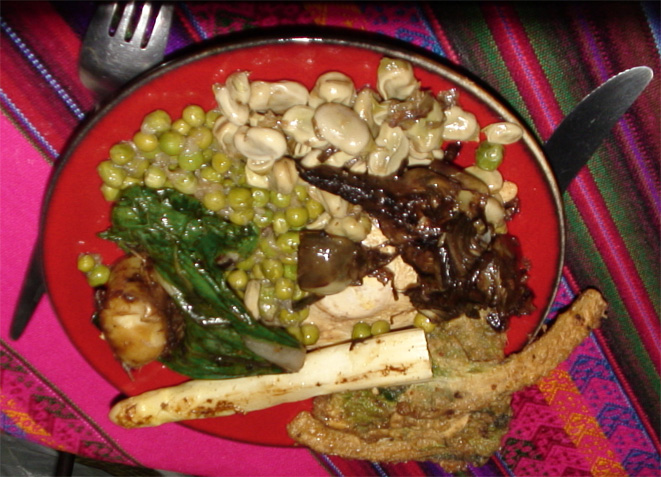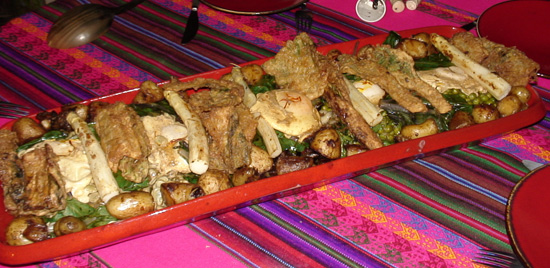“menestra de verdura” : spring is back in the Basque Country
May 11th, 2009 At last Spring has arrived in our plates, in this night of May .
At last Spring has arrived in our plates, in this night of May .
A real treasure : Navara’s Menestra, a rare treat which happens only a short week in the year, when the very first vegetables come young tiny, no fibres, nor floury.
Here we are going to discover the true recipe of the “menestra de verdura” handed down from generation, mouth to mouth, in the Basque kitchens of San Sebastian, the ones that have been the true inspiration of the dean of the Spanish gastronomy, Arzak the genius.
Vegetables always take the longest time to prepare, but they will guaranty you pure pleasure. In the Basque Country this plate gathers mass of people, very serious competitions are organised each year, as soon as the vegetables sprout in Navara. This night, as we come back with our treasure of vegies to Paris, we decided to share with friend this rather confidential treasure.
Ingredients for 5 :
10 small violet artichokes, 2kg tiny fresh peas, 2kg tiny broad beans, 1kg beet, 1/2 kg new tiny yellow potatoes, 2 bunch fresh onions, 1 whole fresh garlic, 50 gr grease of Iberic ham, 20 gr Iberic ham meat, 1 egg, 50gr of flour, safron, salt, organic olive oil, an avocado leaf (which you can replace with a quater of laurel leaf, if you dont have an avocado tree) half a chile pasilla from Oaxaca, guzano salt.
The avocado leaf, the chile pasilla and the gusano salt is a new touch brought by les foodingues to the Basque Cuisine. The avocado leaf brings the smoothness of the avocado fruit to any broth, excellent. The chile pasilla from Oaxaca is an incredible Mexican pepper, the only one sold by unit, which brings an incredible flavour of smoked sweet cherry. The guzano salt is salt cooked with chile and the worm of the cactus with which you make Tequila; this one is the one of Oaxaca mesqual. We have been introduced to these fabulous ingredients by the famous Mexican painter Laura Hernandez.
Use Iberic ham: the fat of this breed of pig is 98% oleic acid, which means that it is no saturated fat; so dont cook it to much so that you wont get bad fats and cholesterol. Choose the bellota one, which has eaten in the last 6 months before being killed oak kernels. My preferate Iberic bellota ham is from Extramadura, because it is a region where you still have huge wild spaces of oak trees where Iberic Porks are raised.
Make sure that all the veggies and ingredients are organic : an organic vegetable has a true tatste, it holds 30% more dry matter than a conventional one (you pay for less water); and also nothing from this plate is going to be thrown away; by buying organic we will be able to use all the peelings, which normally would contaminated with pesticide, to make a wonderfull broth with which we will deglaze all the pans used.
The olive oil should be organic as well, as any chemical put on an olive tree concentrates itself automatically in its fruits… which are used to make olive oil.
The recipe from les foodingues :
All ingredients are cooked separatly and assembled in the end.
Peel all the vegetables, gathering all the peels in a big casserole to make the broth, except the leaves of the artichoke to sour (you can put a few leaves of artichoke to mezmerize your taste buds with the sugars of the vegies).
- the violet articholes : with a bread knife, cut them in two at the level of their belly and take away the top of the leaves; take away the remaning hard leaves on the sides; cut them in quarters, eventually take away the hair; put them on a slow fire in a big pan with the fresh garlic and the garlic leaves cut small, with a generous pinch of salt; let cover for a while without opening; when it sticks on the bottom, which means that you smell slight caramel, open and turn them, stir fry them quickly, add the Iberic ham grease and meat; stir; add a few spoons of broth to deglaze and take away from the fire, put aside and cover.
- peas : melt a bunch of onions in organic olive oil with pinch of salt; throw the peas with some broth; cook on a light fire 10mn;
- with the broad beans : same as with the peas but add the avocado leaf to remove any bitterness.
- asparagus : once peeled, stir fry them in live oil with a pinch of guzano salt; this way of cooking the asparugus concentrate the sugars and flavours which normaly disapear in the water in which you normaly cook them.
- beets : stir fry the green leaves in olive oil; cut the stems into 3 inches bits; put the in flour; whisk the egg with a pinch of guzano salt and safron; dip the floury beet into it an throw them in 1/2cm high of frying hot olive oil.
To fry, always use olive oil it probaby the most heat resistant oil.

Done. display every vegetable with your utmost creativity.
In San Sebastien you would eat this marvel with the famous wine from Getaria the Txakoli , Txakoli Txomin Etxaniz is the most reputed; personaly I’d rather prefer the Txakoli Aizpurua. You serve it while breaking the bubble, pouring it high up from a flat and deep thin glass
In Pamplona, capital of Navara, or in Lodosa, capital of the Spanish vegetables, you might get served one the delights among today’s Spanish white wines the Ossian 2005, a great wine from Castilla y Leon. Quick before the 2005 disapears. But in the historic capital of the Menestra, Tudela, the first menestra made in the year, as it is a microclimate special for vegies, you would be served the exceptional wine from Cintruenigo the “Colleccion“ made by Julian Chivite. To an exceptional dish, an exceptional wine.